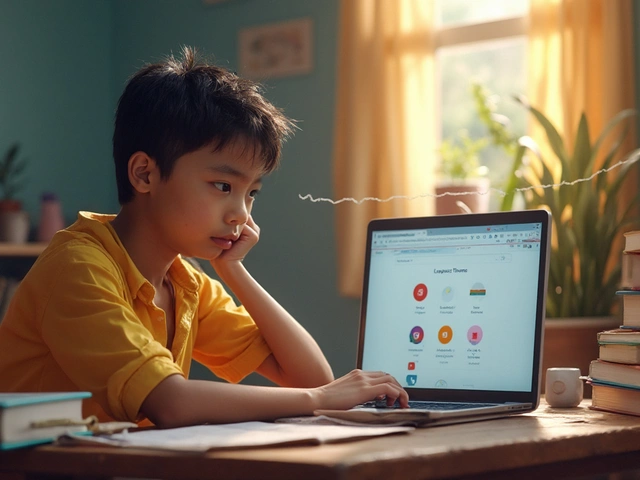You've probably heard whispers or seen posts floating around about Google Classroom shutting down. Let's clear the air. Google Classroom is a key player in the e-learning world, and for a good reason. It's been crucial in managing assignments, fostering communication, and organizing classroom activities seamlessly online.
So, is there any truth to these rumors about its discontinuation? Not officially, no. Google Classroom continues to be supported by Google, helping millions of teachers and students worldwide. Understanding the basis of these rumors can help in navigating e-learning smoother.
Maybe you're relieved, or maybe you're planning for the 'what ifs'. Either way, knowing more about other platforms doesn't hurt. Discovering new tools or even being extra competent with an old favorite like Classroom can only enhance the teaching and learning experience.
- Current Status of Google Classroom
- Rumors About Discontinuation
- Future Trends in E-Learning Platforms
- Alternatives and Transition Tips
Current Status of Google Classroom
As of 2025, Google Classroom remains a highly valued tool in the realm of e-learning. It's not only survived but thrived, evolving with regular updates that cater to market demands and user needs. It's a staple for countless schools and universities due to its straightforward and accessible nature.
Google's continued support ensures that the platform works seamlessly across devices—a necessity as most learning environments demand flexibility. With its integration with other Google services like Google Docs and Google Drive, it makes file sharing and collaboration super easy.
What's New and Improved?
Recently, Google has added features like enhanced grading systems and plagiarism detection tools, making it far more comprehensive and reliable for educators. Moreover, the platform's capability for integration with third-party apps allows for further customization according to specific needs, adding to its adaptability.
Mobile access has been particularly emphasized with significant improvements, ensuring students can participate and teachers can manage classes on the go. Such features are indispensable in today's fast-paced world.
Is it User-Friendly?
The design of Google Classroom is intentionally uncomplicated. Educators appreciate its minimalistic interface which reduces the learning curve, allowing users to focus more on the teaching and learning processes. The platform supports multiple languages, making it inclusive and accessible globally.
Considering privacy and security, which are unanimously significant concerns, Google has also made strides to ensure that data protection complies with necessary regulations, providing peace of mind for institutions dealing with sensitive information.
- Regular updates keep the platform current.
- Integration with third-party apps enhances functionality.
- Data protection and security are prioritized.
- User interface is designed for ease of use.
For something that's been rumored to be on the chopping block, Google Classroom is very much alive and kicking, continually progressing to meet the needs of both educators and students all over the globe.
Rumors About Discontinuation
It's no secret that the digital world is ripe with rumors, and the one about Google Classroom getting the axe has stirred up quite the chatter. But where did this buzz start? Well, some say it comes from Google’s pattern of phasing out older products. Whenever Google makes big changes to their ecosystem, people start to speculate.
The truth is, tech transitions are common. Sometimes companies rebrand or merge features into new suites, and that’s been mistaken as product discontinuation in the past. A lot of the talk can be traced back to forums where folks share stories - some based on reality, others not so much. But is there official word from Google?
"Google Classroom remains a key focus for us, and we're committed to continually supporting teaching and learning experiences globally," said a Google representative in a recent online educational forum discussion.
This reassurance helps clear doubts. Yes, Google has shut down platforms before, like the famous demise of Google Reader, but when it comes to something as crucial as online education, they’re still on board.
Rumors can often overshadow facts, but the current scenario shows that Google Classroom is here to stay. However, staying informed and adaptable is always smart in the tech world. As long as the need for digital classrooms exists, platforms like Google Classroom will likely continue to evolve, not disappear.

Future Trends in E-Learning Platforms
E-learning is evolving at lightning speed, much like other tech-driven fields. So what's on the horizon for platforms like Google Classroom? Spoiler alert: It's mostly exciting stuff!
First up, personalized learning. Platforms are becoming smarter, adapting to students' individual needs. They deliver content tailored just for you, helping to better engage everyone from math whizzes to budding poets.
Enhanced Interactivity
There's a big push towards making online learning more interactive. Think virtual and augmented realities that immerse you in a lesson, rather than staring at static screens. These tools are helping to bridge the gap between theory and practice, making learning more engaging.
Integration with AI and Big Data
Artificial intelligence and big data are reshaping e-learning. AI can analyze student behavior and performance, delivering insights that help educators tweak their teaching methods. As Dr. Maya Kapoor, an expert in educational technology, points out,
"AI in education is not replacing teachers; it's empowering them to know their students better and personalize the learning experience."
Mobile Learning
Learning on the go is more relevant than ever. With smartphones in nearly every pocket, e-learning platforms are optimizing for mobile. This trend is especially crucial in regions where traditional desktops aren't as common.
Moreover, if you've ever struggled with internet access, platforms are trying to make content accessible offline. So, you can review that tricky algebra concept even when camping out in an internet-dead zone.
Lastly, continuous updates and improvements to user interfaces make the platforms easier to navigate. The ultimate goal? A seamless, distraction-free learning journey.
Want to stay ahead of the curve? Keep an eye on these developments and, who knows, you might become the next e-learning trendsetter!
Alternatives and Transition Tips
Switching from Google Classroom can seem daunting, but knowing your options makes it smoother. Here are some solid alternatives and tips on transitioning effectively.
Popular Alternatives
Several platforms offer unique features that might suit your needs.
- Moodle: An open-source platform giving you heaps of customization. You're in control. Perfect for tech-savvy users who want a unique setup.
- Microsoft Teams: Great for schools with Office 365. It integrates well with other Microsoft services, providing a unified experience.
- Schoology: Known for its engaging interface and powerful tools, especially strong in social-learning features.
- Canvas: It’s user-friendly and offers comprehensive teaching tools. It’s popular in higher education.
Transition Tips
Shifting from one platform to another isn’t just about moving files. Here’s how to make it as seamless as possible.
- Assess Your Needs: Identify what features you can't compromise on—be it ease of use, integration capabilities, or specific tools.
- Test Options: Spend some time with trial versions of chosen platforms. Hands-on experience can be revealing.
- Plan the Move: Develop a timeline and checklist for migration. Focus on transferring essential data first.
- Train Your Users: Conduct sessions for teachers and students. Familiarity breeds confidence and efficiency.
- Seek Support: Engage with the support teams of these platforms. Join forums too for additional help and tips.
Here's a quick comparison of some alternatives:
| Platform | Key Feature |
|---|---|
| Moodle | Customization |
| Microsoft Teams | Office 365 Integration |
| Schoology | Social Learning |
| Canvas | User-Friendly Tools |
Switching platforms can open doors to new features that enhance the e-learning experience. Allow time for adjustment, and you’ll find the change could be a net positive for your teaching approach.



